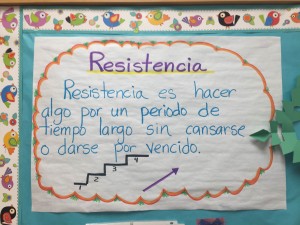Let them read!
At this winter’s Wisconsin State Reading Association Convention, I had the opportunity to attend Donalyn Miller’s session Care and Feeding of a Classroom Library. I happened to stumble upon the session, and I’m so glad I did! It was an inspiration.
Donalyn asked the audience: “Raise your hand if you like to read kids’ or children’s literature?” (we all did)
She then asked: “Raise your hand if you’ve ever learned something about the world from children’s literature?” (we all did)
Then she said: “Guess what? It’s not at your level!”
I believe Donalyn’s purpose was to point out the limitations of rigid adherence to text reading level. While there might be a place for matching readers to leveled texts, we should be cautious about reducing a text to a lexile and reducing a child to a number or letter. This is probably particularly true when working with readers who are bilingual, and books in Spanish possibly lexiled according to English measurements.
Donalyn spoke about the power of independent reading, and classroom libraries as the major vehicle to inspire readers….all readers…. to read. (She writes more about this in her book The Book Whisperer and in her blog The nerdy book club). When students are allowed choice in the books they read, when they have access to a variety of quality children’s books, and when they engage in regular independent reading time, they thrive. When readers are limited to teacher-selected books, when books are scarce or poorly organized, or when kids spend more time on reading-related tasks than in actual reading, our odds are stacked against us.
The session made me reflect on our own classrooms and the prevalence of reading-related activities over actual reading. In schools I work in, it is common for students to be rotating throughout literacy “centers”, working with syllable cards or filling out graphic organizers. Research has proven the value of independent reading (see blog post I’ve got research yes I do, I’ve got research how about you), yet little or no research shows reading-related tasks as an effective use of time. When we consider the planning and preparation required in creating these activities or centers, it’s surprising to me that they seem to dominate independent work time. Maybe we choose them because we want kids to keep busy, to be moving around, or to not misbehave. Maybe it’s simply a habit. Or maybe we haven’t had an opportunity to learn how to set up a classroom library, how to foster silent, sustained, engaged reading, and how to use children’s literature to grow readers.
I’ve decided to pose some simple steps to getting started, along with some supporting resources:
- Get books. The main ingredient for independent reading is the books- lots of them, and good ones. Finding high-interest authentic Spanish literature is not always easy. Check out Colorín Colorado and BooksdelSur for ideas.
- Organize them. Kids need a user-friendly way to find and return the books. You might consider sections organized by genre, by topic, by author, and/or by difficulty. I’ve had great success by involving kids in this task the first week of school as a way to introduce genres. For clear steps in organizing a library, see C.Jayne Teach’s blog. Here are pictures from Maestra Vanessa Sanchez’s classroom:


- Let them read. Scheduling silent sustained reading in a TWI or bilingual program can be challenging. One possibility outlined on page 96 of Teaching for Biliteracy is allowing student choice of English or Spanish texts during independent reading, and providing a reading conference for every child at least once a month in Spanish and once in English. Teachers might also alternate language of independent reading per block or per day.
- Motivate them. In the beginning, goals and incentives can help, as well as talking about stamina. This is an anchor chart from Maestra Sol Barahona’s classroom:
 5. Show off some books. Students are engaged in books when they hear about them! Consider allowing kids to share book recommendations, or providing a short ‘commercial’ for a book a day, or closing reading workshop with share-out circle time. Author’s spotlights can also go a long way.
5. Show off some books. Students are engaged in books when they hear about them! Consider allowing kids to share book recommendations, or providing a short ‘commercial’ for a book a day, or closing reading workshop with share-out circle time. Author’s spotlights can also go a long way.
 6. Repeat steps #1-5. Resist the temptation to create a new “language arts and crafts” activity. Our time is better spent keeping our classroom libraries refreshed and alive, and maximizing the potential of independent reading.
6. Repeat steps #1-5. Resist the temptation to create a new “language arts and crafts” activity. Our time is better spent keeping our classroom libraries refreshed and alive, and maximizing the potential of independent reading.
About the Author: Emily Zoeller
Comment (1)
Comments are closed.


I can´t agree more! Leveled books have an important place in our instruction and are very important as a way to help children grow as readers, but in no way should they be the ¨only¨ books for our students. All students deserve a well developed classroom library that contains many types of books that can be accessed by children in many different ways.